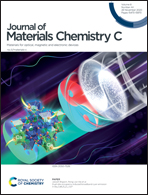Turn-on solid state luminescence by solvent-induced modification of intermolecular interactions†
Abstract
Solid-state luminescent materials that are sensitive to external stimuli are of enormous importance due to their potential for application as smart responsive materials and devices. Here we report the changes in the photophysical properties of a novel benzimidazole-based chromophore upon the formation of an inclusion complex with DMSO molecules in the solid state, and the vapochromic properties of the co-assembly are explored. The chromophore is synthesised in a single step with a good yield. The compound is reasonably emissive in solution, however, it exhibits a red shift and quenching of emission in the solid state. Co-assembly with DMSO results in two distinctly emissive forms, with emission in the yellow (Y-form) and orange (O-form) regions of the visible spectrum. An enhanced emission is observed in the Y-form, while the O-form exhibits efficiency similar to the pristine solid. Various factors that stabilize the co-assembly and the basis of fluorescence enhancement are studied and substantiated by DFT investigations in a QM:MM framework. The crystalline co-assemblies can be reverted to a structure similar to the pristine form by vapours of polar protic solvents, which dramatically modify their photophysical properties. The new materials are therefore promising as vapochromic sensors for environmental monitoring.



 Please wait while we load your content...
Please wait while we load your content...